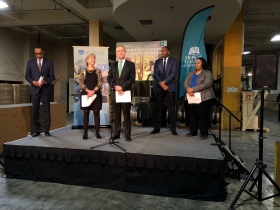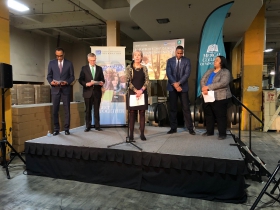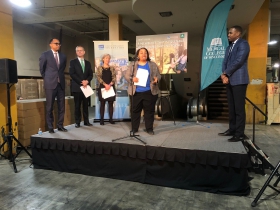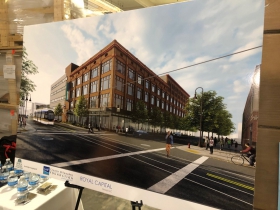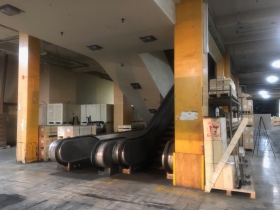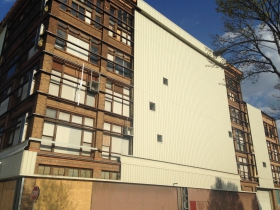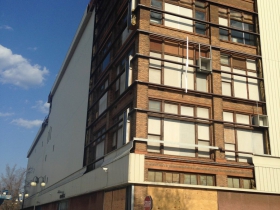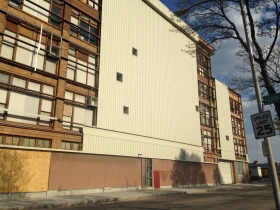City Contributing Up To $15 Million to Schuster’s Project
Financing will support $84 million project for Greater Milwaukee Foundation, Medical College of Wisconsin.

Schuster’s Department Store today (left), conceptual rendering of future plans (right, Engberg Anderson Architects, Kahler Slater).
More details have emerged about the plan to transform the former Schuster’s department store at 2153 N. Martin Luther King Jr. Dr.
Documents released by the Department of City Development show that the city intends to provide up to $15 million to support the redevelopment of the former department store into a shared campus for the Medical College of Wisconsin (MCW) and Greater Milwaukee Foundation (GMF).
The $84.5 million project, first announced in March, would bring two new anchors to Bronzeville and create 77-units of affordable housing on the 350,000-square-foot complex’s upper floors. The anchor institutions would lease approximately 131,000 square feet of space for offices and 40,000 square feet of space for “early childhood education/fitness uses.” Approximately 315 structured parking spaces are planned.
The project will be developed by Royal Capital Group with GMF relocating to the building’s office space from Schlitz Park. The foundation will share the space with MCW which intends to use the space as a home for its community-facing programs. Envisioned with that is the relocation of personnel, including faculty, from the college’s Milwaukee County Medical Center campus in Wauwatosa.
“MCW went through a period of deep internal reflection following the Sherman Park unrest,” said Dr. John R. Raymond, Sr., MCW President and CEO, of the inspiration for the initiative in March. He said the new facility would form a front door for MCW to Milwaukee. The organization’s initiative has the goal of transforming Milwaukee into one of the healthiest and safest cities in the country.
The city’s contribution would take the form of a developer-financed tax-incremental (TIF) financing district. The city would rebate up to $15 million plus 5.5 percent interest over 25 years from the incremental property tax revenue generated by the development. The deal’s term sheet states that the funds will reimburse the costs related to restoring the currently covered facade, development of affordable housing and “other extraordinary costs.”
The building was built in 1907 as a home for Schuster’s and expanded many times. Gimbels acquired Schuster’s in 1961 and operated the store until 1969. It was used as a warehouse by Gimbels until 1992 according to city records. It was then acquired by CH Coakley & Co. which has used the building for storage and office space. Many of the former department store fixtures, including escalators, can still be found in the building.
Included in the deal is a warehouse located across the street from the building at 2212-2228 N. Vel R. Phillips Ave. Royal Capital would redevelop that property as part of the development as well. Two other small properties at the southeast corner of the block filled by the Schuster’s complex, valued at just over $1 million combined, would be included in the district.
The district has a base value of $3,783,300, but the city estimates after redevelopment the value of the district $45,040,893. The bulk of that value, $29,475,000, is estimated to come from the creation of class A office space in the building.
In addition to the TIF, financing for the $84.5 million project is expected to come from commercial loans ($39 million), historic preservation tax credits ($16.6 million), low income housing tax credits ($6.2 million), developer equity ($7.4 million) and a deferred developer fee ($2.7 million). The city’s term sheet gives the expected TIF contribution of $12.6 million, but that amount could grow to $15 million if the building’s assessment comes in higher than expected and results in a negative cash flow for the project. “We are giving some additional cushion to mitigate that risk,” said a DCD representative to Urban Milwaukee via email.
Coakley, through a contractor, had portions of the metal covering on the building’s facade removed in 2015 to assess the facade’s condition. The firm secured historic preservation tax credits at the time, a blessing given that the state now has a $5 million per project cap. Michael Coakley said in March his firm would maintain its office space in the attached building at 2151 N. Martin Luther King Jr. Dr. as part of the project. That office space is currently part of the parcel that contains the bigger Schuster’s building.
The term sheet between the city and Royal Capital Group gives a construction start of September 1st, 2020 with substantial completion by May 1st, 2022.
The proposed district will next be reviewed by the board of the Redevelopment Authority of the City of Milwaukee on October 17th and then by the Common Council.
The Greater Milwaukee Foundation, as promised when the project was announced, continues to hold visioning sessions on what neighbors would like to see in the building and from the two anchors. The next such open house is scheduled from 5 p.m. to 8 p.m. on Friday, October 11th at On the Bayou (2053 N. Martin Luther King Jr. Dr.).
GMF operates 1,306 unique funds with $913 million in assets according to its 2017 annual report. It provided $43.5 million in grants in 2017, over half of which went to community development. Of the 2017 grants, $27.7 million went to 578 agencies located in Milwaukee County.
Department of City Development Commissioner Rocky Marcoux was in attendance at the March project announcement but said no specific ask had been made regarding financing assistance at that point.
Marcoux and others have pointed out the strategic importance of the building given its size and location at the nexus of the Bronzeville, Brewers Hill, Halyard Park and Harambee neighborhoods. It is also near another recently-created TIF district for The Griot and historic Garfield Apartments.
March Unveiling
2015 Facade Exposure
If you think stories like this are important, become a member of Urban Milwaukee and help support real, independent journalism. Plus you get some cool added benefits.
More about the ThriveOn King development
- Inside The Huge ThriveOn King Development - Jeramey Jannene - Apr 24th, 2024
- Malaika Receives $250,000 Challenge Grant from the Fotsch Family Foundation - Malaika Early Learning Center - Nov 3rd, 2023
- Plats and Parcels: Construction Starts on Bronzeville High School - Jeramey Jannene - Nov 20th, 2022
- Friday Photos: Schuster’s Returns to King Drive - Jeramey Jannene - Jul 29th, 2022
- Eyes on Milwaukee: Charter School Reveals New $20 Million High School - Jeramey Jannene - Jul 21st, 2022
- Eyes on Milwaukee: Historic Schuster’s Department Store Getting Exposed - Jeramey Jannene - Jun 30th, 2022
- Eyes on Milwaukee: Work Starting On ThriveOn King Project - Jeramey Jannene - Jun 7th, 2022
- Eyes on Milwaukee: Blood Center Announced As ThriveOn King Tenant - Jeramey Jannene - May 26th, 2022
- New High School Planned in Bronzeville - Jeramey Jannene - May 24th, 2022
- ThriveOn Collaboration Welcomes Versiti as Anchor Tenant - Versiti Blood Center of Wisconsin - May 24th, 2022
Read more about ThriveOn King development here
Eyes on Milwaukee
-
Church, Cupid Partner On Affordable Housing
 Dec 4th, 2023 by Jeramey Jannene
Dec 4th, 2023 by Jeramey Jannene
-
Downtown Building Sells For Nearly Twice Its Assessed Value
 Nov 12th, 2023 by Jeramey Jannene
Nov 12th, 2023 by Jeramey Jannene
-
Immigration Office Moving To 310W Building
 Oct 25th, 2023 by Jeramey Jannene
Oct 25th, 2023 by Jeramey Jannene


